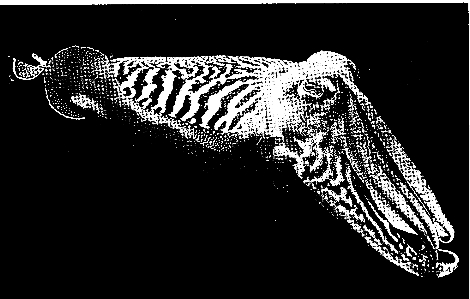Visual Mimicry in Cephalopods
Biology 342 Fall 2007
Aurelia Moran & Matt Lehet
Ontogeny
What is Ontogeny?
Ontogeny is the study of the origin and the development of an organism or species from gamete to mature adult form. Thus, the development of mimicry behavior can be investigated throughout the course of the cephalopod lifecycle.
• Cephalopods are a very difficult species to track and observe, making it difficult to study the development of behaviors in individuals.
• Cuttlefish change the type of mimicry they exhibit over their lifetime, using disguises as hatchlings and intraspecific signals in adulthood.
• Cephalopods have been shown in laboratory settings to habituate, sensitize, and associatively learn. These abilities could aid cephalopods in the development of mimicry behavior
• Cephalopods also have been shown to learn socially. This may one way in which they develop mimicking behavior.
Development of Behaviors in Individuals
It has been consistently difficult to study adult cephalopods in the sea (and even harder to observe young animals). Cephalopods are also difficult to keep, let alone rear in an aquarium. Due to these constraints very little is known about their development. The transition from a hatchling, which is only a few millimeters long, to an adult, often measuring over a meter, must involve significant behavioral alterations as well as physiological changes that with continued study will be better understood.(Hanlon, 1996).
Hatchlings
Hatchlings generally grow up living in sandy substrate on the ocean floor. They come out to at night to feed and remain hidden during the day. Their camouflage places an emphasis on concealment.(Barbosa, 2007). Cuttlefish disguises are largely determined by the visual environment around the cuttlefish, but cuttlefish of different ages (and therefore sizes) displayed different patterns given the same environment. Thus the size of the animal factors into the type of display that is generated (Mathger, 2007). Animals of all ages have very acute vision with adults having marginally better vision (Barbosa, 2007). Young cuttlefish and octopuses also use flamboyant responses to danger which is different than the adult response suggesting ontological developement across these organisms (Hanlon, 1996).

Cuttlefish Hatchling courtesy of www.tenhand.com.
Adulthood
Adult cuttlefish focus their mimicry in efforts to communicate with other adult cuttlefish. Primarily through sexual signaling (Barbosa, 2007). It has been shown that chromatophores density (see Mechanism) decreases with age but that variety of display increases with age (Barbosa, 2007). Adults have also been shown to produce some forms of disruptive coloration that hatchlings do not, which may be the result of chromatophore loss(Hanlon, 1996). Adults are also more likely to display a zebra pattern than the hatchlings, with adult males displaying the intense zebra pattern (a sexual signal). This pattern relies on iridophores and leucophores neither of which have fully developed (or been assimilated into the neural network) in hatchlings (Hanlon, 1996). Adult cephalopods also differ in their response to danger, using a deimatic display (turning white with two to four spots (fewer with age) rather than a flamboyant display (which involves rearing and tenticle flailing)( Hanlon, 1996).

A picture of a sexually mature male cuttlefish with an Intense Zebra display (Hanlon, 2007).
Associative learning, habituation, and sensitization
Octopuses have been trained in a variety of settings to respond for food rewards (Cole, 2005). The most common experimental set up involves training octopuses to attack white rectangles in order to obtain food rewards. The have also been show to habituate to repeated stimuli and sensitize to a stimuli after a shock. Octopuses have also been shown to generalize across stimuli (Hanlon, 1996). These mechanisms though probably not enough to explain complex mimicry behavior support the notion that Cephalopods are particularly intelligent animals capable of complex behaviors.
Social Learning
Octopus vulgaris were allowed to watch trained octupuses attack one of two targets. When tested they attacked the target they had seen the other octopus attack (Fiorito, 1992). This and other experiments have demonstrated that octopuses can learn from one another. This combined with the observation of Huffard (2006) that only half of the octopuses in her study walked using a bipedal gait could suggest a learned component to mimicry.